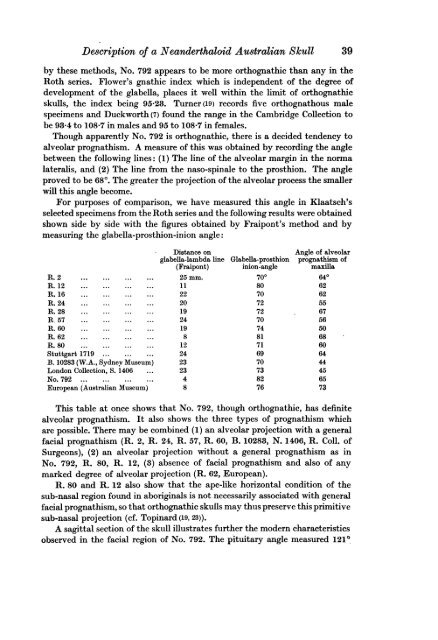THE DESCRIPTION OF A NEANDERTHALOID AUSTRA-
THE DESCRIPTION OF A NEANDERTHALOID AUSTRA-
THE DESCRIPTION OF A NEANDERTHALOID AUSTRA-
Create successful ePaper yourself
Turn your PDF publications into a flip-book with our unique Google optimized e-Paper software.
Description of a Neanderthaloid Australian Skull 39<br />
by these methods, No. 792 appears to be more orthognathic than any in the<br />
Roth series. Flower's gnathic index which is independent of the degree of<br />
development of the glabella, places it well within the limit of orthognathic<br />
skulls, the index being 95X23. Turner(19) records five orthognathous male<br />
specimens and Duckworth (7) found the range in the Cambridge Collection to<br />
be 93X4 to 108-7 in males and 95 to 108-7 in females.<br />
Though apparently No. 792 is orthognathic, there is a decided tendency to<br />
alveolar prognathism. A measure of this was obtained by recording the angle<br />
between the following lines: (1) The line of the alveolar margin in the norma<br />
lateralis, and (2) The line from the naso-spinale to the prosthion. The angle<br />
proved to be 680. The greater the projection of the alveolar process the smaller<br />
will this angle become.<br />
For purposes of comparison, we have measured this angle in Klaatsch's<br />
selected specimens from the Roth series and the following results were obtained<br />
shown side by side with the figures obtained by Fraipont's method and by<br />
measuring the glabella-prosthion-inion angle:<br />
R. 2 ... ... ... ...<br />
R. 12 ... ... ... ...<br />
R. 16 ... ... ... ...<br />
R. 24 ... ... ... ...<br />
R. 28 ... ... ... ...<br />
R. 57 ... ... ... ...<br />
R. 60 ... ... ... ...<br />
R. 62 ... ... ... ...<br />
R. 80 ... ... ... ...<br />
Stuttgart 1719 ... ... ...<br />
B. 10283 (W.A., Sydney Museum)<br />
London Collection, S. 1406 ...<br />
No. 792 ... ... ... ...<br />
European (Australian Museum)<br />
Distance on Angle of alveolar<br />
glabella-lambda line Glabella-prosthion prognathism of<br />
(Fraipont) inion-angle maxilla<br />
25 mm. 700 640<br />
11 80 62<br />
22 70 62<br />
20 72 55<br />
19 72 67<br />
24 70 56<br />
19 74 50<br />
8 81 68<br />
12 71 60<br />
24 69 64<br />
23<br />
2348<br />
This table at once shows that No. 792, though orthognathic, has definite<br />
alveolar prognathism. It also shows the three types of prognathism which<br />
are possible. There may be combined (1) an alveolar projection with a general<br />
facial prognathism (R. 2, R. 24, R. 57, R. 60, B. 10283, N. 1406, R. Coll. of<br />
Surgeons), (2) an alveolar projection without a general prognathism as in<br />
No. 792, R. 80, R. 12, (3) absence of facial prognathism and also of any<br />
marked degree of alveolar projection (R. 62, European).<br />
R. 80 and R. 12 also show that the ape-like horizontal condition of the<br />
sub-nasal region found in aboriginals is not necessarily associated with general<br />
facial prognathism, so that orthognathic skulls may thus preserve this primitive<br />
sub-nasal projection (cf. Topinard (19, 23)).<br />
A sagittal section of the skull illustrates further the modern characteristics<br />
observed in the facial region of No. 792. The pituitary angle measured 121°<br />
70<br />
73<br />
82<br />
76<br />
44<br />
45<br />
65<br />
73

















